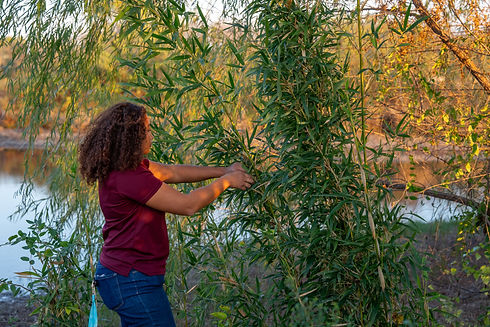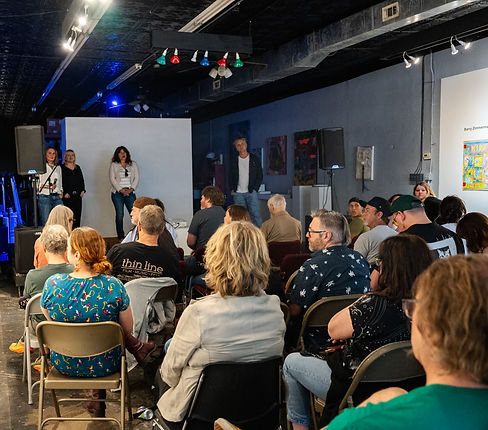

MORE THAN WATER DOCUMENTARY FILM
When Oklahoma threatens to divert the sacred Kiamichi River to Oklahoma City, a grassroots alliance of Native Americans and local communities fights to protect more than just water—they're fighting for their cultural identity, ecological heritage, and survival.
SYNOPSIS
More Than Water is a feature-length documentary that chronicles the David-and-Goliath battle between rural Oklahoma communities and state authorities over the fate of the Kiamichi River. This ancient waterway, whose Caddo name means "the old place, something ancient where we come from," has sustained Indigenous peoples and local communities for countless generations.
In 2016, the Oklahoma Water Resource Board granted a permit to divert water from the Kiamichi Basin to Oklahoma City, 200 miles away. With only 20 days' notice buried in a local newspaper, affected communities mobilized to form the Kiamichi River Legacy Alliance (KRLA). Through intimate portraits of tribal leaders, scientists, and everyday citizens, the film reveals how this legal battle represents a much larger struggle between corporate interests and cultural preservation.
The documentary follows KRLA's founder Dr. Kenneth Roberts, a chemistry professor whose life was literally saved by the river, and Sandra Stroud, a Choctaw Nation citizen who views the Kiamichi as a sentient being deserving of protection. As court battles escalate and the Oklahoma Supreme Court ultimately rules in favor of diversion, the film asks profound questions about environmental justice, Indigenous rights, and what we lose when we reduce sacred places to commodities.
TREATMENT
ACT I: THE SACRED WATERS
25 MINUTES
The film opens with breathtaking aerial footage of the Kiamichi River winding through the lush landscape of Southeast Oklahoma. We hear Caddo Nation Chairman Bobby Gonzalez explaining the untranslatable meaning of "Kiamichi"—a word that speaks to something ancient and profound, like a waterlogged tree sitting peacefully on the river bottom.
Through archival imagery and contemporary footage, we learn the river's complex history. The Caddo people were the first inhabitants until they were forcefully removed to make room for the Choctaw people, themselves displaced from Mississippi. Despite this painful history, both nations consider the Kiamichi sacred.
We meet Sandra Stroud at golden hour, standing in the calm waters offering tobacco in blessing. Her words establish the film's central theme: "The life force of the water is the life force of the people." The river isn't just a resource—it's family.
Dr. Kenneth Roberts' personal story provides emotional weight to the scientific narrative. Growing up poor along the river, his family depended on it for everything—food, water, entertainment, even baths. In his darkest adult moment, only the river provided solace. This personal connection drove him to become a biologist and chemist, viewing the Kiamichi as "more of a family member than a waterway."
The ecological stakes become clear as Dr. Roberts and his university students conduct research. The Kiamichi is Oklahoma's most ecologically diverse river, home to at least five endangered species, including the pocketbook mussel found nowhere else on Earth.
ACT II: THE FIGHT BEGINS (35 minutes)
35 MINUTES
The crisis erupts in 2016 when the Oklahoma Water Resource Board grants a surface water permit allowing Kiamichi water to be piped to Oklahoma City. The notification process is deliberately obscure—a small write-up in a tiny local newspaper giving landowners just 20 days to respond.
From this moment of crisis, the Kiamichi River Legacy Alliance is born. We follow KRLA's formation through town hall meetings where Dr. Roberts and Sandra address concerned citizens. Their message is clear: "We just want them to do the science," but beyond science lies the cultural aspect—"this is more than just a gallon of water."
The documentary captures the grassroots nature of their resistance. With limited resources, KRLA organizes bake sales, raffles, and music festivals on the river banks to raise money for attorney fees. These scenes illustrate both the community's determination and their David-versus-Goliath struggle against well-funded state interests.
Court battles unfold as KRLA appeals one hearing after another. We witness the exhausting legal process, the mounting costs, and the community's growing desperation as they fight through multiple levels of the court system.
A local rancher, representing the area's economic vulnerability, provides stark perspective: "We're the poorest county in the whole state of Oklahoma, and they're just going to come in and take our water. It ain't right, nothing right about it at all."
ACT III: MORE THAN WATER (30 minutes)
30 MINUTES
As legal options dwindle and the Oklahoma Supreme Court rules in favor of diversion in 2023, the film shifts to explore what will be lost. Local business owners explain the economic reality: without water, there's no fishing, no hunting, no tourism. Animals will migrate elsewhere, people will follow, and entire communities will dry up.
We explore the broader cultural fabric through scenes of children, farmers, and tourists drawn to the basin's beauty and tranquility. The river's role extends beyond economics to identity itself—these communities have become who they are because of the Kiamichi.
The film's most powerful sequence takes place at the sacred headwaters. Jerry, a Choctaw healer and river guide, leads fellow tribal members on a difficult pilgrimage to this holy ground. In deafening silence broken only by Jerry's voice, he delivers the film's most haunting prediction: "The people of the Kiamichi basin will be forced to relocate once again. This healing peaceful refuge will be no more. All that will be left in that dried up river bed of the Kiamichi will be artifacts of our people and our life that once was."
Sandra's words echo as the sun sets: "To take from the Kiamichi, is taking more than water."
The film concludes with uncertainty. Will KRLA find resources to continue fighting beyond the Oklahoma Supreme Court? What happens if the water is diverted and the river dries up? The questions remain open, but the stakes are crystal clear.

The Kiamichi River may be in Oklahoma, but its story flows everywhere.
THEMES
ENVIRONMENTAL JUSTICE
The film explores how environmental decisions disproportionately impact rural and Indigenous communities while benefiting urban centers.
CULTURAL PRESERVATION VS. PROGRESS
The tension between economic development and protecting sacred cultural sites drives the narrative conflict.
COMMUNITY RESILIENCE
Despite overwhelming odds, the grassroots organizing demonstrates how communities can mobilize to protect what matters most.
INDIGENOUS RIGHTS
The film illuminates ongoing struggles of Native American communities to protect ancestral lands and waters.
SACRED VS. COMMODITY
The central philosophical question of whether natural resources are sacred entities deserving protection or commodities to be managed for economic benefit.
VISUAL STYLE
The documentary employs a cinematic approach that honors the river's beauty while documenting the human struggle. Aerial drone footage captures the Kiamichi's majesty and the landscape it nourishes. Intimate handheld cameras bring viewers close to personal stories during interviews and community meetings.
Golden hour cinematography emphasizes the spiritual connection between people and place, while archival footage and artifacts provide historical context. The visual approach balances natural beauty with urgent activism, creating an aesthetic that's both contemplative and compelling.

TARGET AUDIENCE
PRIMARY
Documentary film enthusiasts, environmental activists, and audiences interested in Indigenous rights and social justice issues.
SECONDARY
Educational institutions studying environmental policy, Native American studies, and rural sociology.
TERTIARY
Oklahoma residents and those with connections to the American Southwest who may have personal investment in regional water rights issues.

DISTRIBUTION STRATEGY
The film is positioned for festival screenings at events focusing on environmental and Indigenous issues, including Sundance, SXSW, and specialized festivals like the Native American Film Festival. Educational distribution through universities and environmental organizations provides additional revenue streams.
Streaming platforms with documentary focus, particularly those highlighting social justice content, represent the primary commercial distribution path. Community screenings in affected regions can build grassroots support and awareness.
IMPACT CAMPAIGN
Beyond entertainment, More Than Water serves as an advocacy tool for water rights protection and Indigenous sovereignty. Partnerships with environmental organizations, tribal governments, and academic institutions can amplify the film's message and support ongoing legal efforts.
The film provides a template for other communities facing similar water diversion threats, offering both inspiration and practical organizing strategies.
CONCLUSION
More Than Water transforms a local water rights dispute into a universal story about what we value and what we're willing to fight for. Through intimate storytelling and stunning visuals, the film reveals how environmental policy affects real people and sacred places.
At its heart, this is a story about connection—between people and place, past and present, individual and community. As communities worldwide face similar threats to their natural resources, More Than Water offers both a warning and a call to action.


